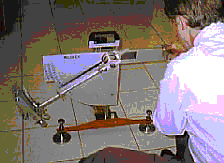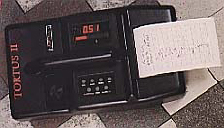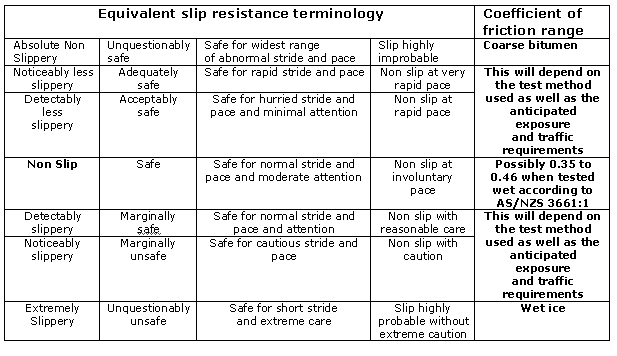Slipperiness and Standards - Overview
Code of compliance regarding to slip resistance is governed by various Codes, Acts, Standards and the Laws, namely;
- Building Code of Australia
- Occupational Health & Safety Act
- Disability Discrimination Act
- Australian Standards
- Local Government DCP's
- Common Law
Relevant Australian Slip Resistance Standards currently in force are;
- AS/NZS 4586, Slip resistance classification of pedestrian surface materials
- AS/NZS 4663, Slip resistance measurement of existing pedestrian surfaces
- HB 197, An introductory guide to the slip resistance of pedestrian surface materials
AS/NZS 4586 & 4663 are standard test procedures to determine slip resistance characteristics HB 197 assesses relative risk and suitability of surfaces evaluated by the standard test procedures.
Standards Defined Slip Resistance Terms
Test Methods
There are four different test methods
(Short descriptions are extracts from http://www.cmit.csiro.au and http://www.cmmt.csiro.au )
- Wet Pendulum Test
De facto in-situ test device, the most commonly used. The pendulum is a portable instrument used in the laboratory or on site for classifying the wet slip resistance of new flooring (pedestrian surface) materials.
Read more about Wet Pendulum Test
Click on the photo below to see VIDEO OF THE PENDULUM IN ACTION (80 seconds):

Above photo and video are courtesy of Safety Direct America. - Dry Floor Friction Test
Although pedestrian surface materials are classified according to the dry floor friction test, there is no notional interpretation of each class. While there are very few new pedestrian surfaces that would have a dry mean coefficient of friction of less than 0.4, they would make a high contribution to the risk of slipping. However, it would be inappropriate to assume that all products that have high coefficients of friction would make a very low contribution to the risk of slipping when dry.
Read more about Dry Floor Friction Test
Click on the photo below to see VIDEO OF THE PENDULUM IN ACTION (80 seconds):

Above photo and video are courtesy of Safety Direct America. - Wet Barefoot Ramp Test
Since slip resistance test methods have inherent limitations, some test methods will be more appropriate for specific circumstances. For instance, since rubber is a poor surrogate for human skin, the wet barefoot ramp test should provide the best indication of slip resistance for areas such as bathrooms.
Read more about Wet Barefoot Ramp Test - Oil Wet Ramp Test
The ramp uses human subjects to subjectively assess the slip resistance of floorings under closely controlled conditions. Ramp testing can evaluate a wider range of products than the wet pendulum test, particularly highly profiled products that are intended to allow drainage or entrapment of contaminants.
Read more about Oil Wet Ramp Test
Methods 1. and 2. are used for testing existing surfaces (in situ), while 3. and 4. are used for classification of new surfaces.
So, which test is the best?
- Best practice in Australia is to specify both pendulum & ramp classification
- Current international thinking is to use pendulum for majority of situations and ramp in 'special circumstances'
- Primary test should one which simulates the most likely contaminants and footwear used to predict frictional system
- Ramp tests cannot be used for in situ monitoring
- Pendulum and Dry FFT are used for onsite evaluation per AS 4663
Relevant tables for slip resistance
How the Non Slip can relate to Coefficient of Friction

Note: Adapted from ASTM D21.06 questionnaire reprinted in Ergonomics, 1985 28(7), 1052
HB 197:1999 An Introductory Guide to the Slip resistance of pedestrian Surface Materials
Two tables Table 3 and table 5 that are really important. Table 3 defines the Minimum Pendulum or Ramp Recommendations for Specific Locations, while Table 5 is a Classification for Commercial and Industrial areas.
Some samples
|
Shopping centre Shopping centre- food court Internal ramps Toilets Entry foyer (wet) Swimming pool surrounds Undercover concourse External stair nosings External walkways External ramps Car parks Commercial kitchens |
Z X X X X W X W W V - - |
R9 R10 R10 R10 R10 B R10 R11 R10 R11 R10 R12 V4 |
For further information about the various test methods please read the article Practical Aspects of Slip Resistance of Stone
For further information where to get the relevant Slip Resistance Standards please visit www.standards.org.au





